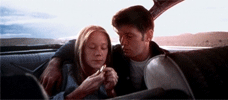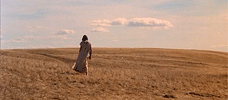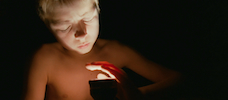Reviews
Terrence Malick
USA, 2011
Credits
Review by Leo Goldsmith
Posted on 27 May 2011
Source Fox Searchlight digital projection
Categories Another World: Terrence Malick at LACMA
Tell us a story from before we can remember.
It seems strange to note that Terrence Malick’s fifth feature, The Tree of Life, is the first of his films to be constructed around flashbacks. In a sense, all of his films recreate and reassemble the hazy, fleeting snapshots of recollection, sudden blazes of light, offhand snatches of conversation, and the delicate movements of bodies and landscapes. But while we enter the memories of a select number of characters in the filmmaker’s recent works - Witt and Bell in The Thin Red Line, John Smith in The New World - these films are usually more enveloped in the minutiae and tactility of an unfolding, if distractable present. In Malick’s films, experience may be fragmented and difficult to grasp hold of, shot through with questions and associations, but it is vividly realized in the persistent presence of the natural world. The fascination with capital-N Nature in Malick’s films - so blithely, weirdly dismissed by those who don’t buy into Malick’s cinema - is then a way of grounding the characters’ experience, their connection to the world, when the present itself can seem so transitory.
To note that The Tree of Life is intimately concerned with the flashback, with memory itself as a structuring device, is to suggest that Malick is here eschewing the usual linearity of his prior films. And, yes, though discursive, all of his films are linear: the titular military linearity of movement of his third film is an obvious clue, but the trajectory of the road trip in his first, the path of the railroad in his second. Each of these films use an exploded, omni-directional form of montage essentially to traverse a linear geography and temporality, punctuated by his trademark “pregnant moments.” These moments erupt in Malick’s films like epiphanies—Witt thinking about his mother dying, or Smith thinking back on “what we knew in the forest.” But in Tree of Life, it is as if these moments have become the entire film. From the vertiginous heights of his office building, against the mirrored skyline of Houston (which is sometimes also Dallas), Jack O’Brien - played by Sean Penn in what amounts to the only images of contemporary life that Malick has ever presented on film - thinks back on his childhood in Waco, Texas, on his parents and his brothers, in a sustained reverie that crisscrosses millennia, that folds space and time into single moments spent on an elevator, or in the antiseptic quiet of an office park.
Tree of Life, in this way, seems unmoored from a linear conception of time and narrative to an extent new to Malick’s cinema and quite foreign to Hollywood cinema generally. Where earlier films compare or even vie with contemporary Hollywood histories - Heaven’s Gate, for example, or Saving Private Ryan - the closest points of reference here are Tarkovsky’s The Mirror or Resnais’s Je t’aime je t’aime, scarmbled excursions through time and memory that grasp at the causes of things. Closer to Tarkovsky still, Malick encodes his film with what seem to be deeply personal references - to his own Texas upbringing under a strict father and doting mother, to the suicide of a brother - suggesting that, while struggling loose of temporal logic, Tree of Life is nonetheless still very much preoccupied with the origins of experience. Jack’s voice asks, “How did I lose you … wandered … forgot you?” This wandering, then, is also a search for a beginning, a meaning, a direction.
Or, indeed, for The Essence of Reasons. This is the English title that Malick gave to his 1969 translation, published the year after his brother’s death, of Heidegger’s lengthy essay, which the philosopher wrote shortly after his groundbreaking 1927 book Being and Time. Malick completed his doctoral work in philosophy at Harvard, studying under Stanley Cavell, a fact often cited to reinforce vague descriptions of the director’s interest in “spiritual things,” but his particular translation of Heidegger’s work is only rarely engaged with directly. (Chris Wisniewski, writing over at Reverse Shot, offers an excellent corrective to this trend, discussing this film in connection with Heidegger’s Introduction to Metaphysics, as well as the Book of Job and Thomas à Kempis.) Dwelling as it does on the origins of knowledge and the divination of “primordial truths,” The Tree of Life provides a fresh opportunity to examine Malick’s cinema in light of Heidegger, who strives for nothing less than an understanding of human consciousness and “being-in-the-world”—that is, of our perception of the world as a collection of things or as a unified whole, and what we know to be true.
These are weighty philosophical issues - for some critics and viewers, preposterously so - and it may be presumptuous to assume that they are any clearer in their cinematic rendering than they are in Heidegger’s cryptic vocabulary. Nonetheless, in evaluating a film so preoccupied with the process of learning about the world - a child’s initiation (or baptism) into language and order1, into ideas about where God lives and how life was first formed - these basic questions at least deserve passing reference. For Heidegger, even the basic conception of what “world” is provokes an array of important questions: is the world a mere collection of all things that exist? Is it a mere subjective understanding of those things and their arrangement? Is it God’s domain, or is it - as Christian theology would have it - distanced from God, something that one must fight against, like sin and the devil in the sermon we hear for Jack’s brother R.L.’s baptism?
Malick’s introduction to his translation offers a hint:
Where Heidegger talks about “world,” he will often appear to be talking about a pervasive interpretation or point of view which we bring to the things of the world. This, in any case, has been the view of many commentators. But there is little sense in speaking of “a point of view” here since precisely what Heidegger wants to indicate with the concept is that none other is possible. And there is no more sense in speaking of an interpretation when, instead of an interpretation, the “world” is meant to be that which can keep us from seeing, or force us to see, that what we have is one.
Jack’s father offers his boys working definitions of “objective” and “subjective,” but Heidegger’s sense of the world lies somewhere beyond or between these. The world is not conceived in isolation (as one’s own world), nor is it something merely material (a world of things); instead, the world comes into being through one’s relation to it, and vice versa. Our consciousness actualizes our surroundings, and this point of view is itself that which makes us sentient beings, makes us beings in the world.
Nature itself, then, is activated by our experience of it, and in Malick’s films, its many forms do not merely stand as eco-friendly eye-candy - what we might call “tree porn” - but as evidence of our own place within a subjective-objective network of understanding: a world. In this way, cinema can function as a way of connecting our points of view with the world, as Stanley Cavell’s book The World Viewed, which acknowledges Malick in its frontmatter, asserts in his explicitly Heideggerian reading of Days of Heaven. For Cavell, cinema is not merely a recording of brute matter; rather, “objects participate in the photographic presence of themselves … they are essential in the making of their appearances.” Thus, the cinematic representation of something so crucial to Malick’s films as nature can be seen not simply in a transparent relationship of “experiencing natural beauty,” but of preserving and even instancing our peculiarly objective/subjective relationship to the world. The world worlds, as Heidegger might say, and both we and the objects of the world viewed collaborate in this process. Cavell: “Objects projected on a screen are inherently reflexive, they occur as self-referential, reflecting upon their physical origins.”
At the outset of The Tree of Life, then, it could be said that Jack has lost this connection to the world, to these origins, and that the film is his way of retracing his steps, or finding his roots. “Find me,” his brother says, and this imperative sends Jack on an excursion not just into his mother’s past - “You spoke to me through her,” Jack says, and the first “recollections” are those of his mother’s childhood - but also to the very beginnings of creation. The elemental formations of life - the Big Bang, Earth’s creation, the first molecular stirrings, encroachments of microbial life onto land and into more complex beings - each of these represents a stage in the creation of a transcendent world, a world of consciousness and self-knowledge.
This is not God’s world, though Jack’s (and probably Malick’s) life is indelibly marked by these ideas. The scope of The Tree of Life is appropriately vast, but as such it also houses divergent philosophies, like the devout, striving, and austere forms of Christianity practiced by his parents. This is a brutal, pragmatic view of the world as one which we must fight our way through - “The world lives by trickery,” Jack’s father cautions - and it’s a world divided up, contested, and apportioned unequally. If we look at the titles of Malick’s prior films, we see the trace of this vision of the world writ large in totemic nouns - land, heaven, line, world - each of these words suggesting a sense of geographic space that must be traversed, defined, delineated, perhaps even claimed for oneself. Each of these films follows a linear passage that is subtended by an ideal: of law and morality, of class, of government, of imperialism. It’s no mistake that the second wave of Malick’s career has hitherto dealt explicitly with the advance of one civilization upon another: “There will be no flanking move!”—instead, there will be a forward movement of bodies in the name of trade and discovery. Or as Sean Penn said, in the film, “The whole thing is about property.”
The middle section of The Tree of Life is full of these demarcations of space and a very real, material sense of “being-in-the world”—tree, house, treehouse, lawn. For Jack and his friends, the network of backyards and back-alleys, and the woods nearby serve as their playground, as territory to be conquered. Glimpses or even incursions into neighbors’ houses are fraught with the guilt, with a sense of transgression beyond the comfortable environs of home and family. Home and family, in this film, are locatable, territorialized, and this sense of spatial logic, of order, is suggestively reasserted by Jack’s adult profession. He is an architect, and we are invited to read his sense of geometry - like his father’s diagrams of his inventions - as an attempt to impose spatial order upon logic. In Malick’s films, geometry vies with chaos: spiraling organisms attack an undulating orb, the rigid structures of downtown Houston (or Dallas?) jut against (or do they merely reflect?) the shapeless cloud-structures in the sky.
For many of Malick’s characters, this project of setting order against chaos might art’s task, or religion’s, but it might also be a trap. The spooky attic is itself a kind of box, a coffin, confining in a way that the O’Brien house - in visions, submerged underwater or open to the heavens - is not. The order and precision of art might free us from the laws and structures of living: certainly, we see Jack’s father most passionate in the enjoyment of music (“Brahms!”), but his ambitions of a life as a musician were frustrated by a certain pragmatism, a sense of the trickery of the world. His perfectionism about music, too, is something he passes on to his son—with what we can understand as tragic results.2 The formal structures of art can be restrictive; they can obsess one in a pursuit of divine perfection, a well-tempered attunement to the music of the spheres. Or they can be engaged with the world; they can approach a form of love and preservation without which, as Jack’s mother advises, “your life will pass by.”
Cinema, for Malick, is a means of love and preservation; it is a way of engaging with the world and of letting the world engage us as subjects, as beings that think and feel. What draws many of us to Malick’s films is, I think, the way in which they are able to mobilize not just cinema, but the entire industrial apparatus of Hollywood - the star system, expert cinematography and lighting, lengthy and expensive periods of editing and post-production; Orson Welles’s “biggest electric train set a boy ever had” - in the service of the most intimate narratives of experience. Much can be said for Malick’s elaborate engagement with the many renowned special effects artists who worked on the film: Douglas Trumbull’s recreation of the Big Bang with paint, water, and high-speed cameras; Dan Glass’s supervision of digital imaging by CalTech and NASA technicians, which rivals his astonishing work on Speed Racer; Peter and Chris Parks’s fluid painting and microphotography.
But Malick’s primary point of reference is actually a quotation, one that he cites alongside the Book of Job: Thomas Wilfred’s 1965 work Opus 161, a paracinematic “color organ” built to play visual music. 3 Malick cites this piece repeatedly as what might be an image of creation itself - Genesis’s first stirrings of light, a divine spark of illuminating color - but it might just as well be the image of human ideation and understanding, the beginnings of an original vision through which to see the world.
- Echoing Tarkovsky, Michael Tully’s review aptly cites Joyce’s _A Portrait of the Artist as a Young Man_ as one of Malick’s points of reference.↩
- As has been reported, Malick’s brother Larry studied classical guitar with Andres Segovia in Spain, but frustrated with his inability to progress, broke his own hands and took his own life. Some have bemoaned Malick’s overwhelming, often blaring and stentorian use of classical music, an aesthetic crutch for filmmakers that I also personally dislike. But the use of music here is appropriate to this film, not only insofar as it is aligned with father and brother, but also because it is derived from predominantly contemporary composers—indeed, composers contemporary with Malick himself, like Preisner (who famously collaborated with Kieslowski), Gorecki, Jovanovic, and Tavener. One gets the sense that Malick sees the works of these composers not simply as hoary classics with obvious emotional cues, but as the artistic strivings of colleagues with similar sensibilities and sets of questions. ↩
- I owe this insight to handmade-cinema scholar and Wilfred specialist Gregory Zinman.↩
More Another World: Terrence Malick at LACMA
We don’t do comments anymore, but you may contact us here or find us on Twitter or Facebook.








